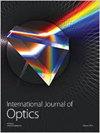The Effectual Spectrum Defragmentation Algorithm with Holding Time Sensitivity in Elastic Optical Network (EON)
IF 1.8
4区 物理与天体物理
Q3 OPTICS
引用次数: 3
Abstract
The elastic optical network (EON) fulfills the upcoming generation network requirements such as high-definition videos, high bandwidth demand services, and ultra-high-definition televisions. The key issues in EON are routing spectrum assignment and spectrum fragmentation for spectrum allocation. The spectrum fragmentation issues are resultant in poor consumption of spectrum resources and an increase in the new connection blocking. A flexible defragmentation algorithm must utilize more spectrum resources with a high transmission rate. This paper presents a new multiconstrained defragmentation algorithm (MCDFA) for elastic optical networks. The MCDFA addressed two key issues: spectrum allocation for new connections and then reconfiguring the existing connections in a nondisruptive manner. The first-last-exact fit spectrum allocation policy assigns the spectrum slots during the new connection request. It splits each light path request by disjoint/ nondisjoint and by efficiently handling the small fragmented slots in spectrum resources. The simulation results are evaluated using standard metrics such as bandwidth blocking probability, bandwidth fragmentation ratio, and spectrum utilization gain. The results also demonstrated that our proposed algorithm generates promised solution to EON’s routing, spectrum assessment, and fragmentation issues.弹性光网络(EON)中具有保持时间敏感性的有效频谱碎片分割算法
弹性光网络(EON)满足了下一代网络的需求,如高清晰度视频、高带宽需求服务和超高清电视。EON中的关键问题是路由频谱分配和频谱分割。频谱碎片化问题导致频谱资源消耗不足,并增加了新的连接阻塞。灵活的碎片整理算法必须以高传输速率利用更多的频谱资源。本文提出了一种新的弹性光网络多约束碎片整理算法(MCDFA)。MCDFA解决了两个关键问题:为新连接分配频谱,然后以无中断的方式重新配置现有连接。第一-最后精确匹配频谱分配策略在新连接请求期间分配频谱时隙。它通过不相交/不分离以及有效处理频谱资源中的小碎片时隙来分割每个光路请求。仿真结果使用标准度量进行评估,如带宽阻塞概率、带宽碎片率和频谱利用增益。结果还表明,我们提出的算法为EON的路由、频谱评估和碎片化问题提供了有希望的解决方案。
本文章由计算机程序翻译,如有差异,请以英文原文为准。
求助全文
约1分钟内获得全文
求助全文
来源期刊

International Journal of Optics
Physics and Astronomy-Atomic and Molecular Physics, and Optics
CiteScore
3.40
自引率
5.90%
发文量
28
审稿时长
13 weeks
期刊介绍:
International Journal of Optics publishes papers on the nature of light, its properties and behaviours, and its interaction with matter. The journal considers both fundamental and highly applied studies, especially those that promise technological solutions for the next generation of systems and devices. As well as original research, International Journal of Optics also publishes focused review articles that examine the state of the art, identify emerging trends, and suggest future directions for developing fields.
 求助内容:
求助内容: 应助结果提醒方式:
应助结果提醒方式:


